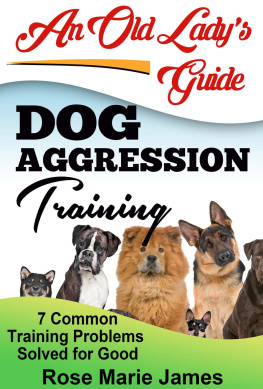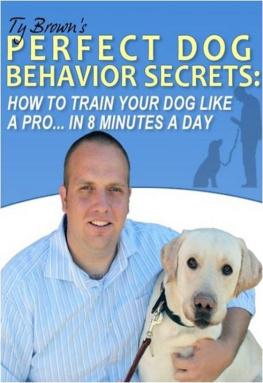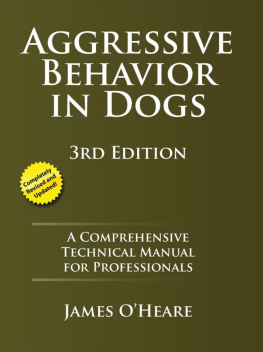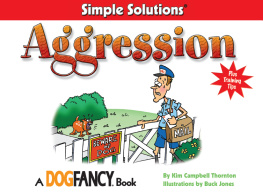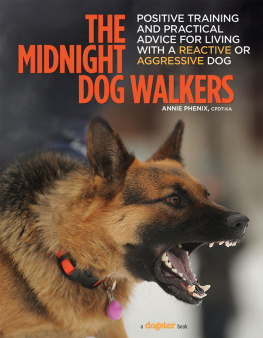Rose Marie James - Dog Aggression Training: 7 Common Training Problems Solved for Good
Here you can read online Rose Marie James - Dog Aggression Training: 7 Common Training Problems Solved for Good full text of the book (entire story) in english for free. Download pdf and epub, get meaning, cover and reviews about this ebook. year: 2015, publisher: JLH Publishing, genre: Home and family. Description of the work, (preface) as well as reviews are available. Best literature library LitArk.com created for fans of good reading and offers a wide selection of genres:
Romance novel
Science fiction
Adventure
Detective
Science
History
Home and family
Prose
Art
Politics
Computer
Non-fiction
Religion
Business
Children
Humor
Choose a favorite category and find really read worthwhile books. Enjoy immersion in the world of imagination, feel the emotions of the characters or learn something new for yourself, make an fascinating discovery.
- Book:Dog Aggression Training: 7 Common Training Problems Solved for Good
- Author:
- Publisher:JLH Publishing
- Genre:
- Year:2015
- Rating:4 / 5
- Favourites:Add to favourites
- Your mark:
- 80
- 1
- 2
- 3
- 4
- 5
Dog Aggression Training: 7 Common Training Problems Solved for Good: summary, description and annotation
We offer to read an annotation, description, summary or preface (depends on what the author of the book "Dog Aggression Training: 7 Common Training Problems Solved for Good" wrote himself). If you haven't found the necessary information about the book — write in the comments, we will try to find it.
The key to successfully eliminating aggressive behavior with your dog is to change your own behavior. This is how you will be able to get your dog to function in a manner that you are accepting of. It will be a way for you to trust them around others and for you to enjoy their company more than ever before!
Dog Aggression Training: 7 Common Training Problems Solved for Good — read online for free the complete book (whole text) full work
Below is the text of the book, divided by pages. System saving the place of the last page read, allows you to conveniently read the book "Dog Aggression Training: 7 Common Training Problems Solved for Good" online for free, without having to search again every time where you left off. Put a bookmark, and you can go to the page where you finished reading at any time.
Font size:
Interval:
Bookmark:
Dog Aggression Training
7 Common Training Problems
Solved for Good
By: Rose Marie James
E very dog has its own personality, just like humans. They can be your best friend and they can always be happy to see you when you get home. However, it can be difficult when you are dealing with the issue of your dog being aggressive.
First of all, this doesnt mean you have failed in any way as a dog owner. It doesnt mean you dont care about your dog or you havent made them a priority. In fact, dog aggression is at the top of the list for most dog owners.
What Causes Dog Aggression?
Understanding the underlying causes of dog aggression is a good place to start. It can provide you with the right frame of mind to make positive changes for you and your dog. What you have been doing to this point hasnt solved the problem. You want to use approaches that get results!
Dont take it personally if your dog is aggressive. Many owners do and it can create resentment for their pet. However, it is the natural instinct of dogs to show dominance and that is where most of the aggression stems from. Frustration is also a natural part of how a dog functions and it too causes aggressive behaviors.
However, you can help your dog to be less frustrated by offering a calm environment and plenty of daily exercise. You can also help your dog to overcome dominance issues by offering a calm but assertive leadership role.
Some breeds of dogs get a bad reputation for being aggressive. However, it isnt the breed that is to blame when a dog isnt behaving. Sure, some breeds seem to have more of a dominant element to them and there are those which are very protective and they make terrific watch dogs.
All Dog Breeds can be Aggressive
However, any breed of dog can be aggressive, even the small Chihuahua. However, it is the damage that can be done by a larger breed of dog when they are aggressive that puts them at the center of the topic. Being chased or bitten by a Chihuahua versus a Pit Bull is a significant difference.
A strong breed of dog is going to be powerful, and you need to accept this. These dogs live with humans but they arent always understood. You cant be intimidated by the breed of dog you have. You cant try to hide them from everyone so they dont have a chance of creating a problem.
One of the chapters in this e-book discusses why you need to be the leader of the pack. Your dog has to know you are dominant over them. They need to know the rules and the boundaries.
Change your Own Behavior
The key to successfully eliminating aggressive behavior with your dog is to change your own behavior. This is how you will be able to get your dog to function in a manner that you are accepting of. It will be a way for you to trust them around others and for you to enjoy their company more than ever before!
Stop blaming yourself for your dog not acting the way you wish they would. Stop being frustrated at your dog because of how they act. Work as a team to make positive changes your entire family will be happy with. Your dog is a member of your family so make sure he or she knows the rules and has plenty of encouragement.
R egardless of the breed of dog, they can experience three natural responses to perceived danger. It is important to understand what you perceive as a threat or danger can be very different from what your dog sees.
This is why you may be struggling to understand what they are dealing with. You may be frustrated because you simply assume your dog is acting out or intentionally misbehaving. That couldnt be further from the truth!
In fact, your dog strives to get your approval and your praise. When you point out that you like what your dog is doing they are going to continue engaging in it. The three natural responses your dog can experience regarding perceived danger include:
- Avoidance Hide from the danger
- Fight - attack the danger
- Flight Run from the danger
A dog who is experiencing fear or anxiety normally wont fight. They are more likely to either hide or run from the perceived danger. Yet if they feel they cant run or they havent been able to hide they may fight. That is when the aggressive behaviors will be seen.
Cycle of Fear and Anxiety Increase Aggressive Behavior
The constant cycle of fear or anxiety can be too much for your dog to handle. Therefore, if the scenario isnt changed or their behavior isnt changed they are going to stop hiding and running and they are going to be aggressive to combat that fear.
The problem with this is the aggressive behavior can carry over to everything else your dog does. They will have internal energy that isnt focused yet it is very high. As a result, they have to find a way to release that energy. Their natural instinct is to release it through aggression.
Exercise to Reduce Negative Energy
Offering your dog plenty of exercise though can be a wonderful way to reduce the high energy that isnt focused. It can help them to be calmer and more submissive. You will also need to show you are the leader of the pack by being assertive.
Offer them firm commands to sit, stay, kennel up, etc. Give them these commands during certain situations so that they realize how you want them to behave. This will be the new behaviors they take part in rather than aggressive behaviors.
Make sure you give your dog plenty of praise when he or she follows the direction you gave. This will be a type of positive reinforcement that encourages them to continue to with that behavior. It will also build up their self-confidence.
Separation Anxiety
Aggressive behavior can also stem from separation anxiety. You may enjoy your dog very much but you are gone for long periods of time. If you work it can be impossible to spend as much time with your dog as you would like or they would benefit from.
If you have various household members that come and go throughout the day, have a plan of action in place for the dog. If each person will spend 10 minutes with the dog it will reduce their separation anxiety. Eventually, they will learn you are gone but soon someone will be home to see them. The cycle will repeat several times per day. Knowing there will be someone to give them attention soon gives them something to look forward to.
If you live alone or no one else can come in throughout the day that lives there, see if someone in the neighborhood can. Perhaps there is a housewife with a child who go walking each day and they could drop in. Maybe there is a school age person down the street and they could come by after school.
Giving someone a small amount of money to spend some time with your dog is worth it. They will enjoy the extra spending cash and you will notice your dog is more relaxed. If none of this is possible, get up earlier and spend time with your dog.
Take them for a walk or spend some time playing with them. As soon as you get home from work, make time for them. Dont rush around with kids and dinner and activities because they will become frustrated if they get ignored.
Come up with some end of the day activities the entire family can take part in. Include your dog in them such as playing in the yard, going for a walk, or even playing catch.
Give your dog a quick pet before you leave. It doesnt have to be a long drawn out goodbye. Tell them bye verbally and touch them physically. This will help to calm your dog. They will be less anxious during your time away.
Make sure your dog has plenty to do while you are away that is proactive! Dont give them the run of the house and then be upset when you find shoes or furniture chewed up!
Give them some toys that help to stimulate them. They should have access to food and water. They should also have access to shade for when it is hot and shelter for when it is cold. Dont chain your dog up or leave them in a kennel all day.
Next pageFont size:
Interval:
Bookmark:
Similar books «Dog Aggression Training: 7 Common Training Problems Solved for Good»
Look at similar books to Dog Aggression Training: 7 Common Training Problems Solved for Good. We have selected literature similar in name and meaning in the hope of providing readers with more options to find new, interesting, not yet read works.
Discussion, reviews of the book Dog Aggression Training: 7 Common Training Problems Solved for Good and just readers' own opinions. Leave your comments, write what you think about the work, its meaning or the main characters. Specify what exactly you liked and what you didn't like, and why you think so.

